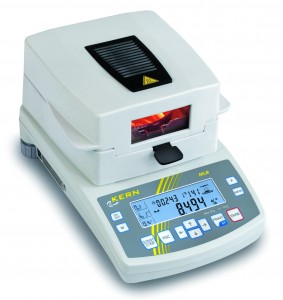Use a Moisture Analyzer for Wood Pellet Quality Control

Wood pellets are becoming more popular as an alternative or supplementary source of heat in many homes and businesses across the land. The Pellet Fuel Institute in October 2011 issued its “Standard Specification for Residential/Commercial Densified Fuel” including recommended moisture content for premium, standard and utility grade wood pellets. A compact moisture analyzer can be used to spot-check moisture content during pellet processing steps.
The Wood Pellet Manufacturing Cycle
A typical 40-pound bag of wood pellets originates as hard- or softwood sawdust, chips, waste materials from furniture and floor manufacturing – virtually any source of wood including trees unsuitable for other uses. The stock is processed to a uniform size with a moisture content of about 13% to 16% prior to the pelletizing operation. Pelletizing is accomplished under high temperatures (~200 ˚F) and pressure (~ 45,000 psi) during which the lignin in the wood serves to bind the particles together without the need for additives.
Drying kilns are used in processing green pellet stock. Moisture content is ascertained by using commercially sized moisture readers positioned along the drying lines to provide real-time measurements. Moisture content can be confirmed by random samples at the end of the drying line and prior to bagging by using a laboratory-grade moisture analyzer such as the Torbal ATS 60 available from Tovatech.
ASTM E-871 is the guide for moisture content cited in the Pellet Fuel Institute standard for moisture content in finished pellets. For premium pellets the standard is ≤ 8%; for standard grade pellets it is ≤ 10%. While this spread does not appear significant, the lower moisture content means that your 40-pound bag contains less water. Also the lower the moisture content the less energy is needed to burn it off. As a comparison cordwood used in fireplaces may have moisture content of 20% to 60%.
Using a Moisture Analyzer
The compact Torbal ATS 60 is constructed as a halogen heater mounted on a precision analytical balance and determines, using the thermogravimetric process, the loss of weight on drying. Random samples of finished wood pellets are distributed evenly on sample plates taking care that they are not piled on each other. The sample plate is placed on the sample plate holder of the analytical balance and the net weight is recorded using the balance tare function.
Using the keypad set the operating criteria for the moisture analyzer. Close the cover and the unit will begin operating. It will terminate when the dry weight is stable or after a pre-set time.
The difference in weight is loss on drying and is equivalent to the moisture content of the sample. Data are displayed on the unit and can be transferred to a printer or PC via an RS 232 interface.
Versatile moisture balances are widely employed across a broad spectrum of industries as a way to confirm moisture content specifications by government agencies and trade associations. Like all precision instruments their use should be governed by procedures outlined in a company’s operation manual. Initial and periodic recalibration operations are critical to maintain weighing accuracy.
Where are moisture analyzers used in your organization to document the moisture content of your products? Describe employee training processes that qualify employees to use moisture balances.
